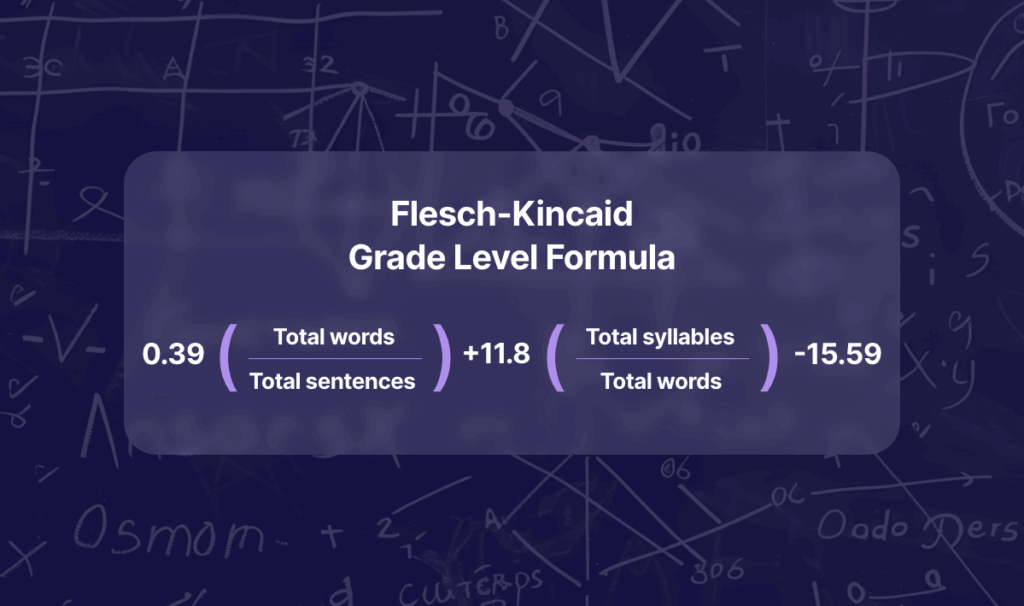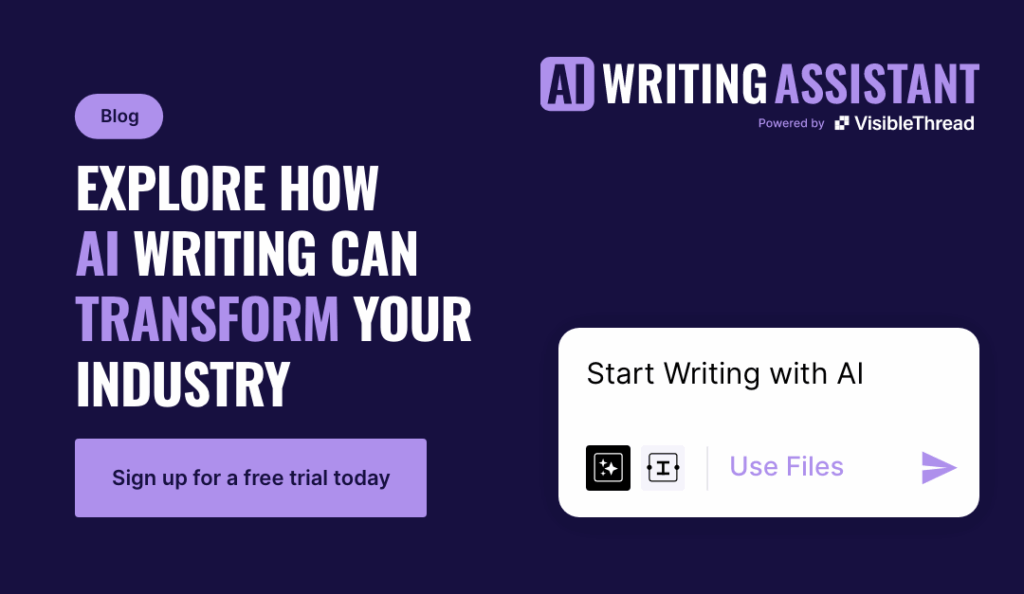- Updated July 10, 2025
The Flesch-Kincaid Grade Level test, developed by Rudolf Flesch, the creater of the flesch reading ease test and J. Peter Kincaid in 1975. It was used by the US military to ensure clear communication and remains one of the most important metrics in content readability. But readability is no longer just about scoring an ideal grade level. AI-driven tools are now transforming how we assess, generate, and optimize content for accessibility and clarity.
As businesses embrace AI writing assistants, they can achieve better results in simplifying complex content and tailoring it to the Flesch-Kincaid Grade Level, all while maintaining accuracy and tone. This is especially important in regulated industries like healthcare, financial services, and government, where communication clarity can be a matter of compliance and user trust.
What is the Flesch-Kincaid Grade Level?
Grade level measures how easy it is to understand a piece of text, quantifying its complexity. The Flesch-Kincaid Grade Level indicates the U.S. school grade that a reader would need to understand the text with ease. The higher the grade level, the harder it is to digest. Content aimed at the general public typically targets grade level 8 or below to ensure accessibility.
However, the landscape has shifted. AI-powered writing tools, like those available in platforms such as VT Writer, now provide businesses with real-time suggestions to improve the Flesch-Kincaid Grade Level of their content. By analyzing the sentence structure, word choice, and syllable count, AI tools help creators maintain readability while crafting complex messages.
What Grade Level is Harry Potter?
The first book in the Harry Potterseries is Harry Potter and the Sorcerer’s Stone, gets a grade level of five. That means you need five years of education to understand it. In the US, you’d be in 5th grade, so about 10-11 years old. That sounds about right, doesn’t it?
Near the other end of the scale, The New Yorker has an average grade level of 11. So you’d need 11 years of education to easily understand it. Again, maybe that sounds about right? The New Yorker is a somewhat high-brow magazine.
But what if I told you that The Affordable Care Act (ACA) has a grade level of 13. It’s more difficult to read than The New Yorker. The ACA aims to make healthcare available and accessible to all. But we know that the average American reads at an 8th grade level. And it’s even worse when it comes to health literacy. In the US, over 75 million adults combined have basic or below basic health literacy. This means people are unable to read instructions on a prescription label and determine what time a person can take medication. Writing at a 6 or below level would ensure that everyone can understand. The ACA itself is therefore seven grade levels too difficult for the general population. Now we’ve got issues.
Why Should You Care About Grade-Level Readability?
Understanding readability is not just a technical exercise; it directly impacts user experience and engagement. Whether you’re designing a user manual for government agencies or drafting communications for a healthcare provider, knowing your content’s grade level ensures it’s accessible to the right audience.
Here’s the twist: AI writing assistants don’t just automate this process—they actively suggest content revisions that can immediately lower the grade level. AI tools analyze your content, then prompt changes to sentence structure, word choice, and overall tone to help ensure clarity and comprehension. As a result, content is not only easier to understand but also more inclusive, which is especially important in regulated industries.
AI Writing Assistants: A Modern Tool for Achieving Grade-Level Accuracy
With the advent of AI-driven content optimization, Flesch-Kincaid Grade Level calculations are no longer limited to manual scoring. In 2025, AI writing assistants offer far more than simple readability assessments—they enhance content clarity, identify overly complex sentences, and even propose simpler synonyms for difficult words.
For example, VT Writer, a leading AI tool for regulated industries, helps you write with precision and clarity while ensuring that your content aligns with the required grade level. This becomes especially crucial for organizations that produce policy documents, training materials, or communications where ease of understanding is non-negotiable.
How AI Writing Assistants Can Help Improve Your Content’s Flesch-Kincaid Grade Level
AI-powered tools have the ability to fine-tune content in real time, automatically adjusting its Flesch-Kincaid Grade Level and ensuring that your messaging is simple yet effective. Here’s how:
Smart Sentence Rewriting: AI tools identify overly long sentences or complex structures and suggest simpler alternatives that still convey the same message, thus improving readability.
Word Choice Optimization: AI systems suggest replacing complicated jargon with simpler terms while maintaining the professional tone needed for regulated industries.
Automated Grade-Level Calculations: AI writing assistants instantly provide a Flesch-Kincaid Grade Level score, allowing writers to see where they stand and make adjustments as needed.
For example, if you’re drafting a healthcare brochure that explains insurance coverage options, an AI writing assistant can ensure that the content is at a 6th-grade level, which is easier for a broader audience to understand.
How is the Flesch Kincaid Grade Level Calculated?
The Grade Level calculation comprises two factors:
- Average syllable count per word and
- Average Sentence length.
The formula for calculating grade level is:

But you’re not expected to work out this math for yourself. Solutions like VT Writer calculate grade level automatically. Along with other important indicators of readability, such as density of passive voice. You simply upload documents or enter text, and the solution scans and scores your content. It allows writers to make sure they stay on track. And enables management to benchmark team performance, and make sure things are moving in the right direction.
How to Achieve the Right Grade Level: 2025 Solutions
As more industries turn to AI writing assistants for content creation and review, measuring and improving Flesch-Kincaid Grade Level has become easier than ever before. But what grade level should you aim for?
Who Are You Writing For?
Consider your audience’s educational background, familiarity with your subject, and the cognitive load required to digest your message. AI tools can help tailor the content to specific reader profiles—whether you’re writing to government officials or patients with limited health literacy.
What is the Purpose of Your Communication?
Use AI writing assistants to fine-tune content based on the level of formality and complexity needed. For instance, you wouldn’t write a legal document at the same grade level as a healthcare pamphlet. AI can analyze the text and suggest edits that will help you strike the right balance.
Why Empathy Matters More Than Grade Level Alone
While Flesch-Kincaid Grade Level is a helpful tool, it shouldn’t be the only metric you consider. AI writing assistants can also incorporate sentiment analysis and contextual understanding to ensure your content resonates with readers, not just from a readability perspective but from an emotional and empathetic standpoint.
Remember, AI technology doesn’t replace human intuition—it enhances it. By focusing on clarity and accessibility, you can create content that meets your audience where they are, helping to reduce cognitive load and deliver your message more effectively.
By integrating AI writing assistants into your content strategy, you’re not only enhancing readability but also ensuring that your messaging is clear, precise, and accessible—essential qualities for any organization in today’s fast-paced, information-driven world. As content standards evolve in 2025, staying ahead of the curve with AI technology can help your team craft content that not only makes the grade but goes beyond.








